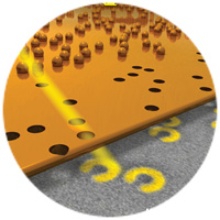Plasmonic materials allow for the manipulation of light fields on a subwavelength length scale and therefore the creation of materials with unusual and highly intriguing electromagnetic properties. In order to fully benefit from the nearly limitless possibilities precise control of material composition as well as the relative and absolute placement of the constituents in three dimensions on a nanometer length scales has to be achieved.
At the 4th Physics Institute we explore and extend a number of different techniques in order to meet the aforementioned prerequisites.
Top-Down Techniques
Top-down nanofabrication techniques such as electron beam lithography and focused ion beam milling are the most versatile techniques which allow us to create two-dimensional materials consisting of metallic as well as dielectric components. In making use of aligned multilayer exposures we can stack two-dimensional planes of structures precisely on top of each other in order to create three-dimensional systems. The adjacent figure depicts a collection of two- and three-dimensional structures (all scale bars are 100 nm) underlining the versatility of top-down lithography.
Further Information
Direct Laser Writing
A tightly focused infrared laser beam can expose a UV photoresist via two photon absorption. This process allows us to write two- as well as true three-dimensional structures in polymers. In a subsequent metallization step we can transfer the pure polymer matrix into a plasmonically active three-dimensional system. In combination with an Argon Ion beam etching step we can also realize large area plasmonic antenna structures.
Further Information
Large-area techniques
Colloidal nanosphere and nanohole lithography allows for complex two- and three-dimensional structures over cm² areas. Polystyrene nanospheres are used to create shadow masks via self-assembly processes which allow us to create highly complex systems.
Multi-exposure laser interference lithography is another powerful technique which allows us to create large area periodic structures of well controlled shapes and sizes.





